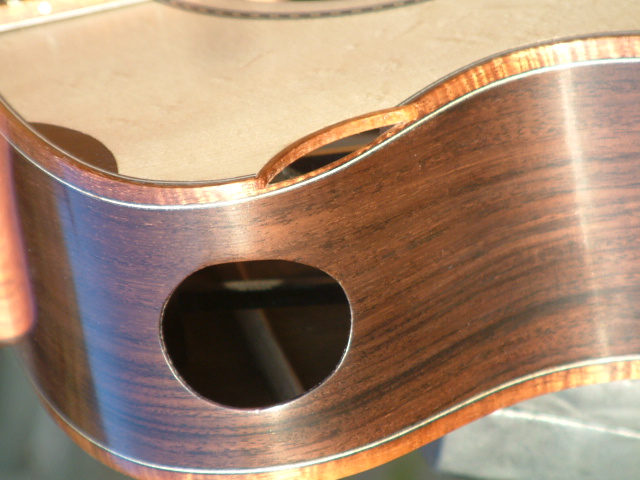After making Weissenborns, a Harp-guitar and a guitar-bouzouki this year I thought it was time to do a simple instrument. So here is the last of my Celtic Festival Series – Lughnasa – a 15 fret clear of the body, multi scale, Manzer wedge with adjustable neck and “woofer/tweeter” sound-ports
 .
.
From my guitar-bouzouki commission earlier this year I ended up with a lovely bearclaw Euro spuce top that developed a tiny crack in the bottom of the treble lower bout and had to come off and be replaced. It had a great tap tone and I didn’t have the heart to do a “Joshua” with it. I already have my own guitar bouzouki, but in my search for the “ultimate dropped tuning fingerstyle guitar” I wanted to experiment with multi-scales and also wanted to see how the Linda Manzer wedge style would work out. So this instrument was conceived and finally born around the already braced top. Removing the top opened up numerous opportunities for creative inlays
 (De Faoite bling) and a final twist of fate on final sanding allowed the formation of the “tweeter” sound port in the tops bass-side upper bout just down from the side sound port.
(De Faoite bling) and a final twist of fate on final sanding allowed the formation of the “tweeter” sound port in the tops bass-side upper bout just down from the side sound port.
The specs are as follows:
Bearclaw Euro spruce top, EIR back and sides
Flamed koa bindings with bwb side and top purfling.
Mahogany neck with bubinga heel.
Old Rio rosewood headstock veneers, end graft, heel cap and nut
Kingwood bridge with bone split-saddle and koa bridge-pins
Ebony fretboard bound with curly koa.
Gotoh tuners with ebony buttons.
Finish is Pre-cat lacquer (over Z-poxy on b/s) and Tru-oil over Z-Poxy on the neck.
Scale length: 630mm to 657mm (24.8” to 25.9”)
The strings went on on Monday. I thought it appropriate to play and record a Martin Simpson arrangement on this guitar as it was Martin that inspired and opened my eyes and ears to altered tunings. This is his arrangement of the Irish air “The Streets of Derry” that he played in 2001 at a weekend guitar workshop in Little Grove, Bucks, and I transcribed it from his playing. It's in CSus2 tuning – CGCGCD.
The Streets of Derry
The fanned frets are easy to play and you forget all about the odd shape pretty quickly. The guitar has a really lovely reverby quality from the EIR and great volume and sustain. It will be interesting to hear it open up. I need to recut and fit another nut as the string spacings are a little off- this is one of the trickier parts of the fanned frets piece. I got the idea for the Rosewood nut from a guitar made by Matt Mustapick that was posted on another forum. It works well and sounds great. At some stage I’ll make a bone one just to compare the sound. The top “Tweeter” sound port definitely adds something positive to the sound and the guitar sounds and feels much more full and open when I uncover it. It can’t yet describe its effect in more detail and need to do some more playing to do so. Here are some pics - thanks for looking and listening:




"Woofer/Tweeter" sound-port:


And the top bracing:

 a thousand times
a thousand times
 The wedge really helps with the comfort factor and doesn't hurt the sound.
The wedge really helps with the comfort factor and doesn't hurt the sound.
 I'm glad you like the shape. There is a lot of tribute to the great Stefan Sobell's guitars in it.
I'm glad you like the shape. There is a lot of tribute to the great Stefan Sobell's guitars in it.
